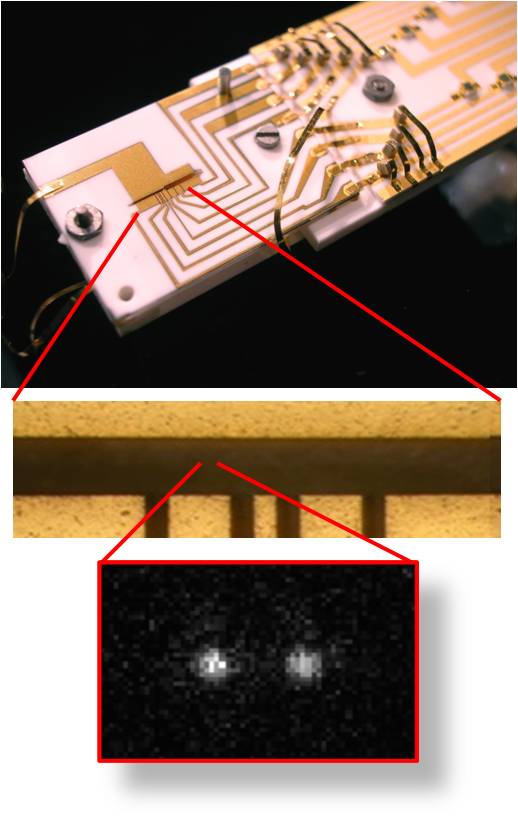Research
On this page we give a basic description of the general research interests of the group. For specific information about our projects please visit the pages for the respective projects.
Trapped-Ion Introduction
Basics: Trapping and manipulating strings of individual atoms
In the picture below is the ion trap that I (Jonathan Home) used in the external pageNIST ion storage groupcall_made. Towards the left of the wafer can be seen a slot, surrounded by gold electrodes. Ions are trapped by applying a combination of static and radio-frequency voltages to these gold electrodes. The trap sits in ultra-high vacuum, meaning that the ions are highly isolated from external perturbations.
A pair of trapped atoms (ions) can also be seen in the image. The ions are separated from each other by 4 microns - they repel each other because they are charged. The image is taken by shining laser light on the ions which is resonant with a transition between two energy levels. The ion scatters this light (through absorption and emission) into all directions. We pick up a small fraction of the light and direct it to a camera - here you are seeing the sum of all the light hitting the camera in a time window of 200 milliseconds. For internal state detection in quantum information experiments, we typically collect the light using a Photo-Multiplier-Tube for a time of 200 microseconds.
The gold electrodes at the bottom of the picture are divided into 8 segments (5 shown in middle image). By applying time-varying potentials to these electrodes we are able to control the trapping potential at the ion. This allows us to move the ions along the axis of the trap, and also to change the trap confinement during the experiment.
If a trapped ion is cold, it makes small excursions about its equilibrium position. This typically means that it sees only a harmonic potential. A laser-cooled trapped ion is deep in the quantum mechanical regime, so the motion is quantized (the energy levels are discrete), each equally spaced in energy by hbar times the vibrational frequency. For motional superposition states of trapped ions, coherence times of up to 170 milliseconds have been observed.
Since the ions are trapped in high vacuum, they are isolated from external perturbations. This means that the internal electronic states of trapped ions are good candidates for manipulating quantum states. Quantum superposition states have been kept "alive" inside a trapped ion for up to 15 seconds. In order to control the ions, laser light is used which is close to resonance with the energy difference between pairs of electronic states. This allows coherent transitions to be made on microsecond timescales.

